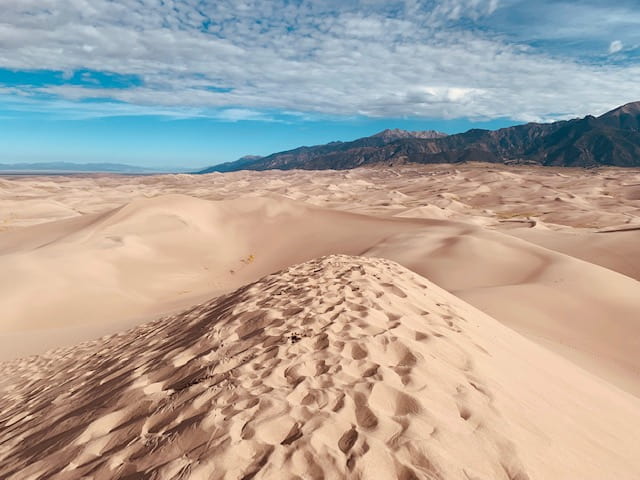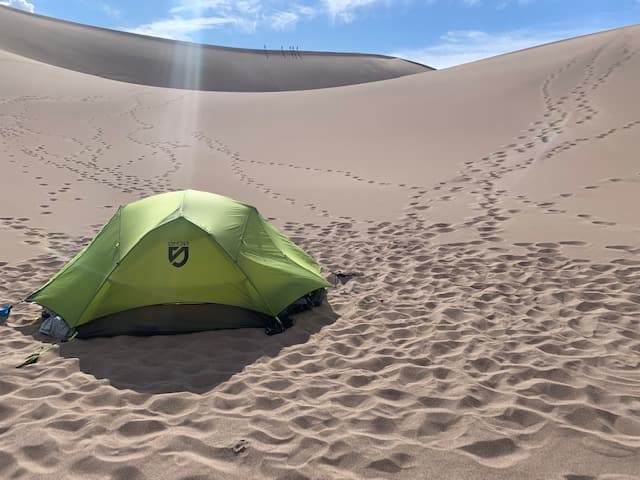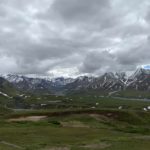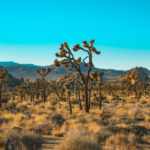Camping in Great Sand Dune National Park is a great way to enjoy nature and get away from the hustle and bustle of everyday life. The park offers camping sites at different locations throughout the year.
Great Sand Dunes National Monument is located in northwest Colorado near the Nebraska border. It was established in 1935 and covers over 3,500 acres. Great Sand Dunes National Park has a variety of campsites to choose from.
Trevorocity is reader-supported. When you buy through links on this site, we may earn an affiliate commission.
How to Get to Great Sand Dunes National Park
The easiest airport to fly into to get to Great Sand Dunes National Park is the Denver International Airport. The airport is located about 4 hours away from the National Park. Denver airport is serviced by almost every major airline and flying a flight in and out is usually pretty easy.
Two alternative airports you can fly into are Colorado Spring Airport and Albuquerque Airport. The Colorado Springs Airport is heavily serviced by Frontier and finding a direct flight is usually a little more difficult. However, using the Colorado Springs Airport will save you some time on driving, it is only a 2 and half hour drive.
The Albuquerque Airport is about a 4 hour drive from Great Sand Dunes National Park, similar to Denver International Airport. A major perk of the Albuquerque Airport is that car rental prices tend to be a lot cheaper than in Colorado.

When to go Camping in Great Sand Dunes National Park
The Great Sand Dunes National Park has extreme weather on both sides of the spectrum. During the summer (June, July and August) months average high temperatures can get to around 80 degrees Fahrenheit. Although this might not seem that hot, there is virtually no shade at Great Sand Dunes National Park and during the summer months the sand can reach up to 150 degrees Fahrenheit.
On the other hand the winter months can get below freezing. In January the average low temperature is only 9 degrees Fahrenheit. February and March follow with just a little bit of an increase of the average low. You can also expect it to possibly snow during these months.
The best time to visit and camp in Great Sand Dunes National park is between late August through October. Although higher chances of rain, the temperatures are much more bearable.
Tips for Visiting and Camping in Great Sand Dunes National Park
This is probably the millionth time that you have heard or read this, but get the America the Beautiful Pass. This pass will allow you free entrance to National Parks for a year. The entrance fee for Great Sand Dunes National Park is $25.
Dogs are allowed to visit Great Sand Dunes National Park, and even accompany you into the backcountry! Remember though sand temperatures are much higher than the actual temperature outside. Checking the sand temperature can make it an enjoyable and safe trip for both you and your dog.
If you are camping in the Sand Dunes National Preserve some areas might require storage from bears, such as a Bear Vault. Local rangers will be able to provide this information.
Pack plenty of water and sunscreen, once you start hiking in the dunes there is no access to water and very limited amounts of shade.
Sandboards and Sandsleds can be rented right outside the entrance of the park for a daily rate at the Oasis Store.
Camping in Great Sand Dunes National Park
Great Sand Dunes National Park offers both camping at designated campgrounds within the park, as well as backcountry camping. If you are looking to camp outside of the Great Sand Dunes National Park TheDyrt can give you some great options.
Designated Campgrounds in Great Sand Dunes National Park
There are technically two designated campgrounds in Great Sand Dunes National Park. One is a lot easier to access than the other. Pinon Flats Campground is located near the visitor center of the park.
It is open from April through October and has 88 campsites. This campsite does allow RVs or tents and costs $20/night. The campground does have toilets, sinks and water spigots. However, it does not have a shower.
If you have a 4 wheel drive vehicle, Medano Pass is worth checking out. This road has 21 campsites along the 22 mile road. All of these sites are first come first serve and are free to anyone camping there.

Backcountry Camping in Great Sand Dunes National Park
In my opinion backcountry camping in Great Sand Dunes National Park is the best way to see the park. Not only are the night stars amazing since there is very little light pollution, it is easy to hike to Star Dune at sunrise before large crowds arrive.
Permits are required to camp in the backcountry and can be reserved on Recreation.gov. There are two different types of backcountry permits. There are 7 designated campsites along the Sand Ramp Trail and 20 non-designated campsites within the sand dunes.
If you plan on camping in the sand dunes you must hike over the west ridge of the day-use area. This will take about 1.5 hours of hiking on unique terrain. Once you are over the ridge you can choose wherever you’d like to camp. Just a warning, dustorms can and do occur. Some nights might get a little sandy.
Packing List
This list is only to be used as a guide on what to pack and may not be fully inclusive to everything that you require. Backcountry has a great variety of clothing and gear for your backpacking trip to Great Sand Dunes National Park.





[…] Colorado and looking to visit a dog friendly National Park? Try checking out Great Sand Dunes National Park. This park is a hidden gem, and will help you escape from some of the bigger National Parks in […]